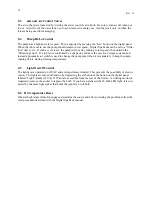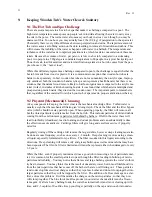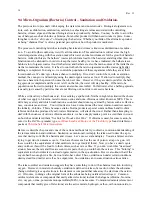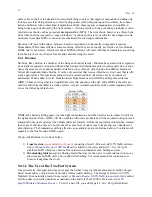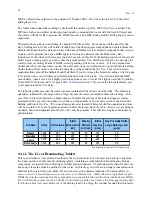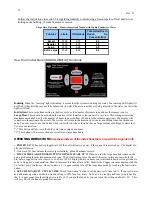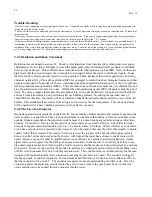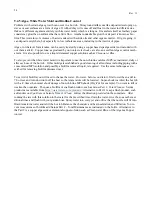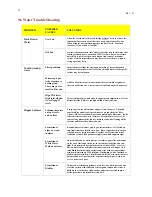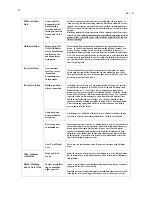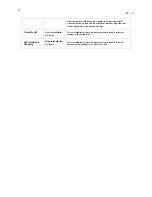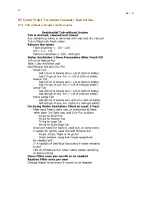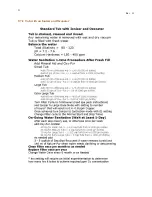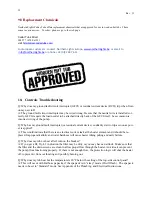
17
Rev 13
name some. In the hot tub situation, the important thing to note is that organic compounds, including oils,
lotions, as well as living microbes, contain hydrogen and carbon. Depending on the oxidizer, its concen-
tration and factors like contact time, temperature and pH, these organic compounds are susceptible to
being broken up or destroyed by the right oxidizer. A strong oxidizer in the pool and spa industry is often
referred to as shock, such as potassium
m
ono
p
er
s
ulfate (MPS). The term shock, however is a throw-back
from when chlorine was used to “super chlorinate” or shock pool water to oxidize the dead organic waste
materials. Nowadays MPS or ozonators are substituted for such super-chlorination.
Bromine will react with amines (nitrogen- based compounds) to form smelly compound s known as
bromamides. While these still have some sanitizing effect they are not nearly as effective as free bromine,
HOBr, that is not smelly. Oxidizers such as MPS and Ozone will react with these bromamides converting
them back to the more effective free bromine and removing the smell.
9.4.1 Bromine
Bromine, like chlorine, is a member of the halogen chemical family. Bromine has gained wide acceptance
as a sanitizer especially on spa/hot tubs and has become the dominant sanitizer because users do not expe-
rience the same level of odours and skin irritation as they often do with chlorine. In addition, bromine is
far less pH dependent than chlorine. It is the only sanitizer that we use (chlorine we don’t use) that is offi-
cially approved as a full-spectrum sanitizer when a certain residual (base line of active bromine) is
maintained. When added to water, bromine forms Hypobromous acid (HOBr) and Hypobromide ions
(OBR
-
). These exist together in an equilibrium state that depends on the pH. Only HOBr is the effective
sanitizer and while the OBR
-
is a weak oxidizer, it exists in small quantities at the normal required pH lev-
els, as the following table shows:
Percent Active
pH HOBr OBr
-
6.0 100%
0%
7.0
99%
1%
7.5
94%
6%
8.0
83%
17%
9.0
30%
70%
HOBr is the bacteria killing agent, if at the right concentration and if the bacteria are in contact with it for
the right amount of time. HOBr will also combine with waste products and if these contain nitrogen (such
ammonia from sweat and urine) then bromamides are formed. Unlike the equivalent chloramines, formed
in the case of chlorine, these do not produce the same level of odour (not to imply they are odourless) or
skin irritation. The bromamides still are effective as a sanitizer, and, as mentioned above, if oxidized will
separate to the free bromine, HOBr, again.
We provide Bromine in two basic forms:
1)
2-part system
(recommended to be used)
consisting of part 1-
Mineral-Aid
(35% NaBr salt solu-
tion)
or
Bromine Booster
(100% NaBr salt)
is added to the water and part 2 –
Oxy-Pur
(pH
stabilized MPS which is a chlorine free oxidizer) is added after each bathing session.
2)
Brominating tablets
used in a floating feeder that stays in the water in combination with an oxi-
dizer treatment (MPS or
Oxy-Pur
) added after bathing. Not recommended for continuous use
because it degrades the wood.
9.4.1.1 The Use of the Two-Part System
If used correctly, this approach does not expose the bather to any significant amounts of smelly nitrogen
based bromamines or high levels of bromine while actually bathing. The first part,
Mineral Aid
(35%
NaBr salt brine naturally present in sea water)
or
Bromine-Booster
(100% NaBr in powder form)
is added
at fill-up time in specific quantities as outlined on the bottle (125 ml/1000 l of
Mineral-Aid
or
50
gms/1000 liters of
Bromine Booster
. Then, if a new fill, you add the part 2 –
Oxy-Pur
(pH stabilized








